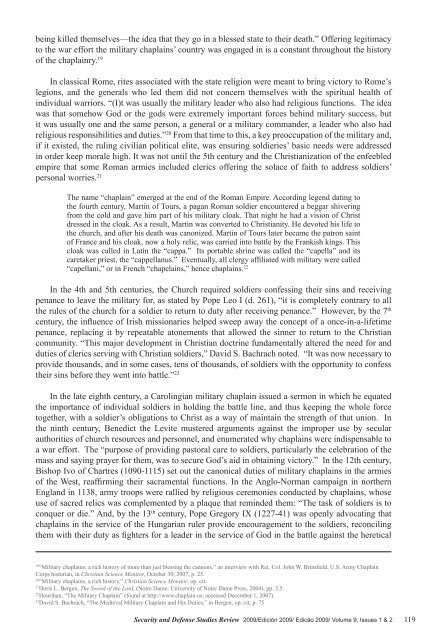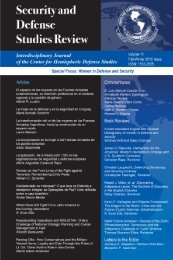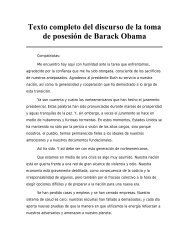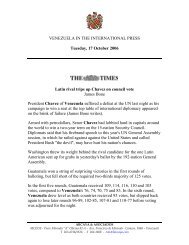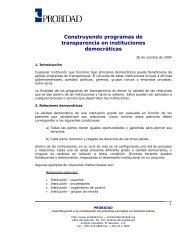The concept of strategic communications as a war-fighting tool, the definition of which is stillbeing debated by U.S. policy <strong>and</strong> military leaders, has come to the fore in the first decade of the21 st century, as U.S. forces sought to first overthrow Iraqi dictator Saddam Hussein, then pacify theethnically <strong>and</strong> religiously fractious nation-state by trying to create stable democratic institutions,in a campaign that has proven much more costly <strong>and</strong> bloody than originally foreseen. Faced withboth international criticism <strong>and</strong> dissent at home, integrating communications is now seen as key toeffective military strategy <strong>and</strong> tactics, with a premium placed on its being inserted at an early stateinto the policy development process. From there, “stratcomm” is supposed to accompany the policiesthat are developed as they are translated into concrete action—all the way to the battlefield, <strong>and</strong>beyond, to post-conflict scenarios such as peacekeeping <strong>and</strong> stability operations. 16Ironically, strategic communication can be seen as the decanted essence of religious dogma. Ithas “its roots in the true <strong>and</strong> classic meaning” of “propag<strong>and</strong>a,” a word whose etymology is tracedto Gregory XV, the Catholic pope who in 1622 created the Sacred Congregation for the Propagationof the Faith as part of the Roman curia. Its mission was to, in Latin, “propagare” Catholic doctrine,a spreading of the word whose English derivatives include “propagate” <strong>and</strong> “propag<strong>and</strong>a.”Unfortunately, with the advent of World War II <strong>and</strong> the “Big Lie” techniques of the German Nazis, theword propag<strong>and</strong>a was discredited <strong>and</strong> no longer meant the mere use of accurate, factual <strong>info</strong>rmationto buttress one’s case. 17It is no accident that military chaplains have played the role that is now ascribed to the realmof strategic communications. As one respected communications expert has noted: “Successfulstrategic communications assumes a defensible policy, a respectable identity, a core value.” 18 Carefulexamination of the role played by military chaplains in the United States <strong>and</strong> other countries showsthat wartime policies tend to be seen as more defensible when advocated by people of the cloth,whose very identity is seen by large sectors of the population as both respectable <strong>and</strong> intrinsicallyvalue-laden.Among the issues that will be examined in this paper are a comparative look at the role playedby military chaplainry in other countries throughout history, as well as the strategic communicationsroles played by the U.S. military chaplains in the Civil War; in a major government policy initiative(the establishment of character education in the U.S. Army in the period 1947-1977), <strong>and</strong> as a resultof the relationship between the U.S. military <strong>and</strong> the Catholic Church during World War I <strong>and</strong> WorldWar II.The Roads Leading to Military Chaplaincy <strong>and</strong> Strategic Communication AbroadThe question about whether military chaplains’ role is in war largely to boost soldiers’ morale—“tofight hard <strong>and</strong> face death bravely” in the service of king <strong>and</strong> comm<strong>and</strong>er, advancing the cause ofvictory—or to act as spiritual counselors, tending to their individual needs, dates almost to the verybeginnings of the profession. The Five Books of Moses makes reference to priests joining troopsinto battle: “And it shall be when you are come nigh unto battle that the priest shall approach <strong>and</strong>speak unto the people” (Deut. 20:2-4). Although the earliest roots of military chaplainry date toancient Rome or even before, over time chaplains became “particularly important in combat becausethe idea of the chaplain is both to bring the blessing of the God or the gods to the cause of the army,but also to strengthen the fighting power, the morale, of individual soldiers <strong>and</strong> of providing thesacrament to soldiers who were prepared to kill other people. … And also soldiers who are risking16See, for example, Chaplain William Sean Lee, Col. Christopher J. Burke, <strong>and</strong> Col. Zonna M. Crayne, Military Chaplains as Peace Builders;17Embracing Indigenous Religions in Stability Operations (Maxwell Air ForceBase: Air University Press, 2004).17Halloran, op. cit., p. 2.18Ibid, p. 3.118<strong>Security</strong> <strong>and</strong> <strong>Defense</strong> <strong>Studies</strong> <strong>Review</strong> 2009/Edición 2009/ Edicão 2009/ Volume 9, Issues 1 & 2
eing killed themselves—the idea that they go in a blessed state to their death.” Offering legitimacyto the war effort the military chaplains’ country was engaged in is a constant throughout the historyof the chaplainry. 19In classical Rome, rites associated with the state religion were meant to bring victory to Rome’slegions, <strong>and</strong> the generals who led them did not concern themselves with the spiritual health ofindividual warriors. “(I)t was usually the military leader who also had religious functions. The ideawas that somehow God or the gods were extremely important forces behind military success, butit was usually one <strong>and</strong> the same person, a general or a military comm<strong>and</strong>er, a leader who also hadreligious responsibilities <strong>and</strong> duties.” 20 From that time to this, a key preoccupation of the military <strong>and</strong>,if it existed, the ruling civilian political elite, was ensuring soldieries’ basic needs were addressedin order keep morale high. It was not until the 5th century <strong>and</strong> the Christianization of the enfeebledempire that some Roman armies included clerics offering the solace of faith to address soldiers’personal worries. 21The name “chaplain” emerged at the end of the Roman Empire. According legend dating tothe fourth century, Martin of Tours, a pagan Roman soldier encountered a beggar shiveringfrom the cold <strong>and</strong> gave him part of his military cloak. That night he had a vision of Christdressed in the cloak. As a result, Martin was converted to Christianity. He devoted his life tothe church, <strong>and</strong> after his death was canonized. Martin of Tours later became the patron saintof France <strong>and</strong> his cloak, now a holy relic, was carried into battle by the Frankish kings. Thiscloak was called in Latin the “cappa.” Its portable shrine was called the “capella” <strong>and</strong> itscaretaker priest, the “cappellanus.” Eventually, all clergy affiliated with military were called“capellani,” or in French “chapelains,” hence chaplains. 22In the 4th <strong>and</strong> 5th centuries, the Church required soldiers confessing their sins <strong>and</strong> receivingpenance to leave the military for, as stated by Pope Leo I (d. 261), “it is completely contrary to allthe rules of the church for a soldier to return to duty after receiving penance.” However, by the 7 thcentury, the influence of Irish missionaries helped sweep away the concept of a once-in-a-lifetimepenance, replacing it by repeatable atonements that allowed the sinner to return to the Christiancommunity. “This major development in Christian doctrine fundamentally altered the need for <strong>and</strong>duties of clerics serving with Christian soldiers,” David S. Bachrach noted. “It was now necessary toprovide thous<strong>and</strong>s, <strong>and</strong> in some cases, tens of thous<strong>and</strong>s, of soldiers with the opportunity to confesstheir sins before they went into battle.” 23In the late eighth century, a Carolingian military chaplain issued a sermon in which he equatedthe importance of individual soldiers in holding the battle line, <strong>and</strong> thus keeping the whole forcetogether, with a soldier’s obligations to Christ as a way of maintain the strength of that union. Inthe ninth century, Benedict the Levite mustered arguments against the improper use by secularauthorities of church resources <strong>and</strong> personnel, <strong>and</strong> enumerated why chaplains were indispensable toa war effort. The “purpose of providing pastoral care to soldiers, particularly the celebration of themass <strong>and</strong> saying prayer for them, was to secure God’s aid in obtaining victory.” In the 12th century,Bishop Ivo of Chartres (1090-1115) set out the canonical duties of military chaplains in the armiesof the West, reaffirming their sacramental functions. In the Anglo-Norman campaign in northernEngl<strong>and</strong> in 1138, army troops were rallied by religious ceremonies conducted by chaplains, whoseuse of sacred relics was complemented by a plaque that reminded them: “The task of soldiers is toconquer or die.” And, by the 13 th century, Pope Gregory IX (1227-41) was openly advocating thatchaplains in the service of the Hungarian ruler provide encouragement to the soldiers, reconcilingthem with their duty as fighters for a leader in the service of God in the battle against the heretical19“Military chaplains: a rich history of more than just blessing the cannons,” an interview with Ret. Col. John W. Brinsfield, U.S. Army ChaplainCorps historian, in Christian Science Monitor, October 30, 2007, p. 25.20“Military chaplains, a rich history,” Christian Science Monitor, op. cit.21Doris L. Bergen, The Sword of the Lord, (Notre Dame: University of Notre Dame Press, 2004), pp. 3,5.22Hourihan, “The Military Chaplain” (found at http://www.chaplain.us; accessed December 1, 2007).23David S. Bachrach, “The Medieval Military Chaplain <strong>and</strong> His Duties,” in Bergen, op. cit, p. 75<strong>Security</strong> <strong>and</strong> <strong>Defense</strong> <strong>Studies</strong> <strong>Review</strong> 2009/Edición 2009/ Edicão 2009/ Volume 9, Issues 1 & 2 119
- Page 4 and 5:
Document: Speech on “Security, In
- Page 6 and 7:
6Security and Defense Studies Revie
- Page 8 and 9:
un tema de seguridad y defensa porq
- Page 10 and 11:
Los Intereses de la República Popu
- Page 12 and 13:
En el marco estratégico descrito e
- Page 14 and 15:
Works (FAW), Geeley, Dongfeng, y Ch
- Page 16 and 17:
interés en participar en el yacimi
- Page 18 and 19:
al emplear personas locales en todo
- Page 20 and 21:
había un banco en Colombia especia
- Page 22 and 23:
ehén de los FARC, escribe de siete
- Page 24 and 25:
estadounidenses en el futuro, y por
- Page 26 and 27:
26Security and Defense Studies Revi
- Page 28 and 29:
Existe numerosa literatura que trat
- Page 30 and 31:
La Tabla 1.1, demuestra que el apor
- Page 32:
Los cuestionamiento a este modelo d
- Page 35 and 36:
….derogaremos la Ley del Cobre y
- Page 37 and 38:
Figura 4.3.Aporte de CODELCO por ve
- Page 39:
Figura 6.Elaboración propia distri
- Page 42 and 43:
de los proyectos de defensa necesit
- Page 44 and 45:
En el caso de las inversiones en de
- Page 46 and 47:
Anexo 1PROTOCOLO DE ACUERDO QUE ACO
- Page 48 and 49:
OECD. “Models of Public Budgeting
- Page 50 and 51:
proyectos nacionales y democrático
- Page 52 and 53:
DesprofesionalizaciónEn la región
- Page 54 and 55:
Según algunos autores, “no sorpr
- Page 56 and 57:
(antinarcóticos), la Guardia Coste
- Page 58 and 59:
supervigilen las acciones intrusiva
- Page 60 and 61:
Quizás una de las fallas provenga
- Page 62 and 63:
Junto con ello se elaboró una nuev
- Page 64 and 65:
Colombia). Por otro, hay una serie
- Page 66 and 67:
Maldonado, Carlos, “Profesionalis
- Page 68 and 69: policías y militares no ha estado
- Page 70: La relación entre fuerzas militare
- Page 73 and 74: dictaduras. En aquellos con más tr
- Page 75 and 76: efectos de planificación se ha hab
- Page 77 and 78: BibliografíaAguila, Ernesto y Mald
- Page 79 and 80: Sherman, Lawrence. et.al. 1973. Tea
- Page 81: Influenza Pandemic and its National
- Page 84 and 85: and restaurant services” is expec
- Page 86 and 87: The ability of the health sector to
- Page 88 and 89: BibliographyAlmond, D. and B. Mazum
- Page 90 and 91: El trabajo parte del supuesto de qu
- Page 92 and 93: es tanto una elección voluntaria c
- Page 94 and 95: Por otro lado, Rusia nunca ha visto
- Page 96 and 97: La Organización del Tratado del At
- Page 98 and 99: liquidez internacional pero tambié
- Page 100 and 101: petróleo recientemente descubierta
- Page 102 and 103: Dentro de este esquema, Estados Uni
- Page 104 and 105: 104Security and Defense Studies Rev
- Page 106 and 107: minimize a number of attempts at fo
- Page 108 and 109: kidnapping, of Maria Edith de Deber
- Page 110 and 111: The political campaign that resulte
- Page 112 and 113: would carry out the more violent ta
- Page 114 and 115: of the EPP so far, is the relative
- Page 117: to accept ideas, policies or course
- Page 122 and 123: In Latin America, the role played b
- Page 124 and 125: the Church to be given to the dying
- Page 126 and 127: from providing military chaplains t
- Page 128 and 129: Perhaps one of the clearest example
- Page 130 and 131: was prepared by the Office of the C
- Page 132 and 133: 132Security and Defense Studies Rev
- Page 135 and 136: Keynote Speech by Dr. Frank O. Mora
- Page 137 and 138: If successful, these infrastructure
- Page 139 and 140: Security, Intelligence and the Role
- Page 141 and 142: Clearly, security, intelligence and
- Page 143 and 144: Contratapa(Contratapa offers, in a
- Page 145 and 146: efforts have become intertwined; fo
- Page 147 and 148: comprensión de sus valores y cultu


